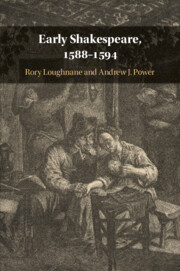Book contents
- Early Shakespeare, 1588–1594
- Early Shakespeare, 1588–1594
- Copyright page
- Contents
- Tables
- Notes on Contributors
- Acknowledgements
- Abbreviations
- Introduction Beginning with Shakespeare
- Chapter 1 Shakespeare and the Idea of Early Authorship
- Chapter 2 Collaboration and Shakespeare’s Early Career
- Chapter 3 The Language and Style of Early Shakespeare
- Chapter 4 Shakespeare’s Early Verse Style
- Chapter 5 Early Shakespeare, Chaucer, and Narrative Theory:
- Chapter 6 Poetry, Counsel, and Coercion in Shakespeare’s Early History Plays
- Chapter 7 John Lyly and Shakespeare’s Early Career
- Chapter 8 Spenser and Shakespeare: Bards of a Feather?
- Chapter 9 Arden of Faversham, Richard Burbage, and the Early Shakespeare Canon
- Chapter 10 Boy Parts in Early Shakespeare
- Chapter 11 The Origins of Richard Duke of York
- Chapter 12 Early Shakespeare and the Authorship of The Taming of the Shrew
- Chapter 13 Who Read What When?
- Book part
- Select Bibliography
- Index
Chapter 7 - John Lyly and Shakespeare’s Early Career
Published online by Cambridge University Press: 17 April 2020
- Early Shakespeare, 1588–1594
- Early Shakespeare, 1588–1594
- Copyright page
- Contents
- Tables
- Notes on Contributors
- Acknowledgements
- Abbreviations
- Introduction Beginning with Shakespeare
- Chapter 1 Shakespeare and the Idea of Early Authorship
- Chapter 2 Collaboration and Shakespeare’s Early Career
- Chapter 3 The Language and Style of Early Shakespeare
- Chapter 4 Shakespeare’s Early Verse Style
- Chapter 5 Early Shakespeare, Chaucer, and Narrative Theory:
- Chapter 6 Poetry, Counsel, and Coercion in Shakespeare’s Early History Plays
- Chapter 7 John Lyly and Shakespeare’s Early Career
- Chapter 8 Spenser and Shakespeare: Bards of a Feather?
- Chapter 9 Arden of Faversham, Richard Burbage, and the Early Shakespeare Canon
- Chapter 10 Boy Parts in Early Shakespeare
- Chapter 11 The Origins of Richard Duke of York
- Chapter 12 Early Shakespeare and the Authorship of The Taming of the Shrew
- Chapter 13 Who Read What When?
- Book part
- Select Bibliography
- Index
Summary
When he wrote Gallathea, Lyly combined certain elements which might be said to be at the heart of Shakespearean comedy: cross-dressed lovers, woods as spaces for personal discovery, supernatural imps with power over human interaction, a narrative moving towards marriage against seemingly irreconcilable odds. Though Shakespeare’s earlier plays, such as The Two Gentlemen of Verona and Love’s Labour’s Lost, are most often described as Lylian, every one of his comedies engages with some combination of these elements, and towards the end of his career, in the second scene of The Tempest Shakespeare can be seen rewriting the first scene of Gallathea. This chapter will give this side of Shakespeare’s authorship a new emphasis by juxtaposing it with different elements of Lyly’s influence over his early career, charting the use of Lyly’s prose fiction in Two Gentlemen of Verona and his play The Woman in the Moon in Titus Andronicus. By looking at various kinds of influence – generic, structural, performative, tonal – this chapter will present a new understanding of Shakespeare’s early use of Lyly’s work.
- Type
- Chapter
- Information
- Early Shakespeare, 1588–1594 , pp. 167 - 179Publisher: Cambridge University PressPrint publication year: 2020

